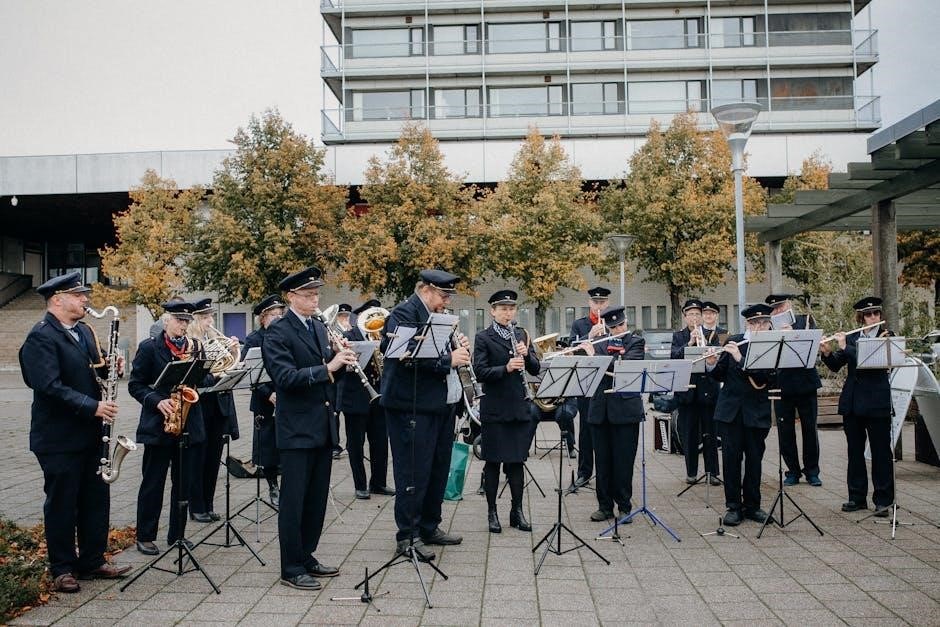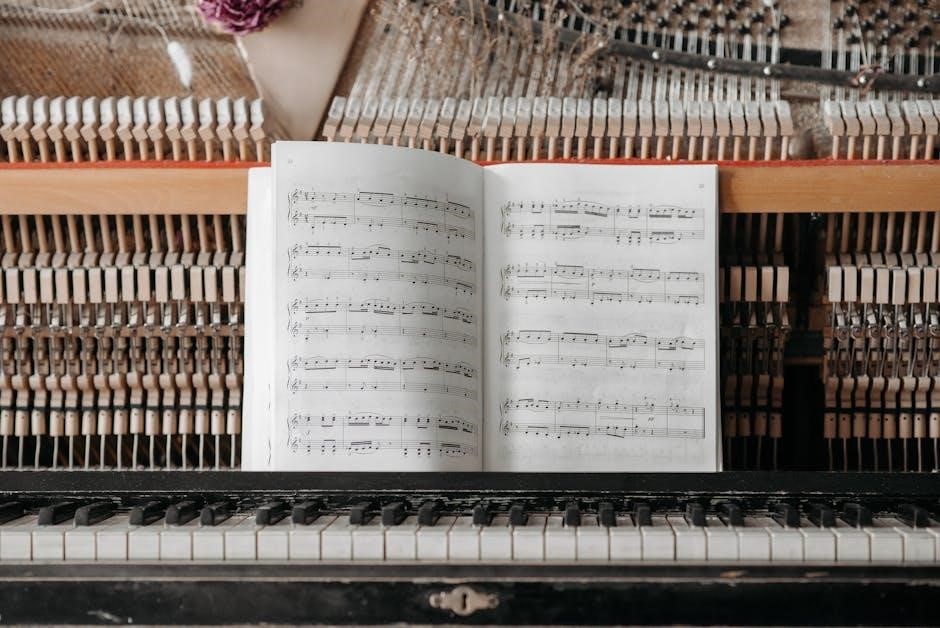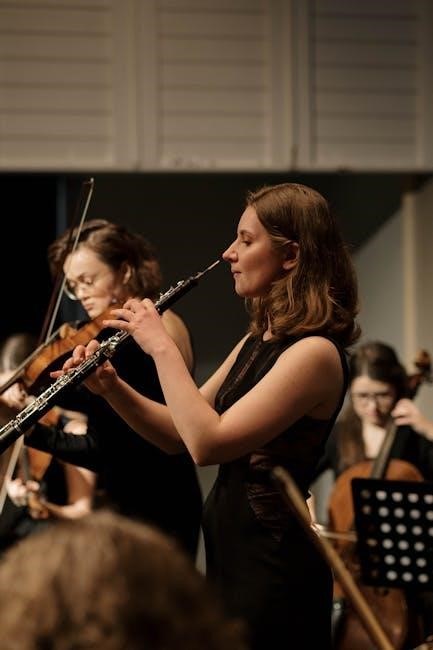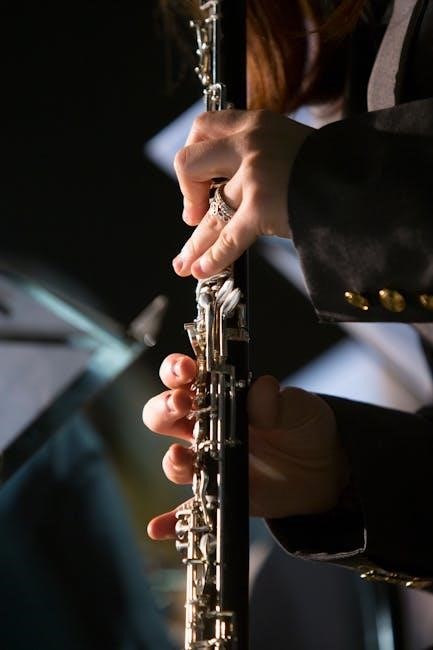Aaron Copland’s Clarinet Concerto stands as a cornerstone of 20th-century American music. It was commissioned by Benny Goodman, bridging the gap between classical and jazz idioms.
Overview of the Concerto
Copland’s Clarinet Concerto, completed in 1948, is a captivating blend of classical structure and jazz-infused melodies. Commissioned by the renowned Benny Goodman, the concerto showcases the clarinet’s versatility, transitioning from lyrical beauty to vibrant, rhythmic energy. The work is structured in two movements, a departure from the traditional three-movement form, creating a unique and compelling listening experience.
The first movement, slow and expressive, features Copland’s signature pastoral style, evoking a sense of tranquility and spaciousness. In contrast, the second movement bursts with playful energy, incorporating elements of swing and Latin rhythms. The concerto’s overall effect is a vibrant tapestry of sound, showcasing the clarinet’s capabilities in both its lyrical and virtuosic registers. It remains a beloved piece, performed and appreciated worldwide. The piece is written in two parts.
Historical Context of the Composition
Copland’s Clarinet Concerto emerged from a period of significant artistic growth and exploration in American music. Composed in the late 1940s, following World War II, it reflects the burgeoning American identity and a desire to forge a distinct national sound. Copland, already a celebrated composer known for works like “Appalachian Spring” and “Billy the Kid,” sought to bridge the gap between classical music and popular idioms, particularly jazz.
The commission from Benny Goodman, a legendary figure in both classical and jazz circles, was pivotal. Goodman’s request for a concerto that blended these genres perfectly aligned with Copland’s artistic vision. This collaboration resulted in a work that not only showcased the clarinet’s versatility but also captured the spirit of postwar America, a time of optimism, innovation, and cultural fusion. The end result was one of the most treasured concertos of all time.

Availability of the PDF Score
Securing a PDF score of Copland’s Clarinet Concerto requires navigating copyright laws and licensing agreements. Legitimate sources offer authorized versions, ensuring both quality and respect for the composer’s intellectual property.
Legitimate Sources for Purchasing the Score
For musicians seeking a high-quality and legally obtained PDF score of Copland’s Clarinet Concerto, several reputable sources offer reliable options. These sources ensure adherence to copyright regulations and provide assurance that the purchase supports the composer’s estate and publishers.
Music retailers specializing in sheet music, such as Sheet Music Plus and JW Pepper, are excellent starting points. These vendors often have licensing agreements with Boosey & Hawkes, the concerto’s publisher, guaranteeing the authenticity of the score; Purchasing directly from Boosey & Hawkes’ website is another dependable avenue, offering a direct connection to the source.
University music libraries and academic institutions sometimes provide access to digital scores through their online databases, although these are typically restricted to students and faculty. Always verify the terms of use before downloading any material.
Be wary of unauthorized websites offering free downloads, as these often infringe on copyright and may contain inaccurate or incomplete versions of the score. Investing in a legitimate copy ensures both ethical practice and a superior musical experience.
Public Domain Status and Legal Considerations
The Copland Clarinet Concerto is not currently in the public domain in most countries. Copyright laws protect musical works for a certain period after the composer’s death, and Aaron Copland passed away in 1990. Therefore, the concerto remains under copyright protection, typically administered by the publisher, Boosey & Hawkes.
Downloading or distributing unauthorized copies of the score is a violation of copyright law. This includes scanning a physical copy and sharing it online or making multiple copies for performance without proper licensing. Such actions can lead to legal repercussions, including fines and potential lawsuits.
Performers and educators should ensure they have the necessary performance licenses and permissions before performing or distributing the work. These licenses are often obtained through performing rights organizations like ASCAP or BMI. While excerpts may be used for educational purposes under fair use guidelines, the entire score cannot be freely distributed without permission.
Respecting copyright laws ensures that composers and publishers are compensated for their work, fostering a sustainable environment for artistic creation.

Analysis of the Concerto’s Structure
The concerto unfolds in two contrasting movements. The first is lyrical and expressive, showcasing Copland’s signature pastoral style. The second movement is a lively, jazzy romp.
Movement Breakdown and Key Themes
Copland’s Clarinet Concerto is structured in two movements, a departure from the traditional three-movement concerto form. The first movement, marked “Slowly and expressively,” is characterized by its lyrical melodies and gentle, pastoral atmosphere. The clarinet sings a melancholic tune, supported by subtle orchestral textures. This movement evokes a sense of tranquility and introspection, with hints of Copland’s signature Americana style. The key themes are introduced and developed gradually, creating a sense of unfolding beauty.
The second movement, “Rather fast,” bursts forth with energy and rhythmic vitality. It’s a stark contrast to the first movement, embracing jazz influences and showcasing the clarinet’s virtuosity. The themes are more fragmented and syncopated, driving the music forward with a playful spirit. The movement incorporates elements of swing and improvisation, reflecting Benny Goodman’s background. A cadenza allows the clarinetist to display their technical prowess before the exhilarating conclusion, blending classical structure with jazzy improvisation.
Instrumentation and Orchestration Techniques
Copland’s Clarinet Concerto features a relatively small orchestra, comprising strings, harp, piano, and percussion, alongside the solo clarinet. This intimate ensemble allows the clarinet’s timbre to shine through, creating a transparent and balanced sound. Copland masterfully utilizes the orchestra to complement and support the clarinet’s melodic lines. The string section provides a lush and warm backdrop, while the harp and piano add delicate textures and shimmering colors.
The percussion instruments are used sparingly but effectively, enhancing the rhythmic vitality of the second movement and adding subtle accents throughout. Copland’s orchestration techniques are characterized by clarity and precision, ensuring that each instrument contributes to the overall sonic landscape. He skillfully balances the various instrumental forces, creating a vibrant and engaging dialogue between the soloist and the orchestra. The concerto showcases Copland’s ability to evoke a wide range of emotions through his masterful use of instrumentation and orchestration.

Performance Considerations
Performing Copland’s Clarinet Concerto demands a blend of technical prowess and artistic sensitivity. The clarinetist must navigate challenging passages while capturing the music’s lyrical and jazzy essence.
Technical Challenges for the Clarinetist
Copland’s Clarinet Concerto presents several technical hurdles for the performer. The piece requires exceptional breath control to sustain the long, lyrical phrases, especially in the first movement. The wide leaps and rapid articulation demand precise fingerwork and embouchure control, testing the clarinetist’s agility.
Intonation can be particularly challenging due to the concerto’s chromaticism and the clarinet’s inherent tendencies. The jazzy passages necessitate a mastery of various articulation styles, including staccato, legato, and flutter-tonguing. The second movement’s cadenza demands virtuosic display, requiring improvisation skills and a deep understanding of the concerto’s harmonic language.
Furthermore, the clarinetist must possess a strong sense of rhythm and timing to accurately execute the syncopated rhythms and complex rhythmic patterns. Overall, Copland’s concerto is a demanding work that pushes the technical boundaries of the clarinet, requiring a highly skilled and experienced performer.
Interpretational Aspects and Stylistic Nuances
Beyond technical prowess, Copland’s Clarinet Concerto demands a nuanced interpretation. The soloist must capture the concerto’s unique blend of classical and jazz idioms, conveying both its lyrical beauty and rhythmic vitality. The first movement requires a sensitive and expressive approach, highlighting the clarinet’s singing quality.
The second movement, with its jazzy inflections, calls for a more improvisational and playful style. The soloist must navigate the contrasting moods and textures, seamlessly transitioning between moments of introspection and exuberance. The cadenza offers an opportunity for personal expression, allowing the clarinetist to showcase their individual artistry;
A successful performance hinges on understanding Copland’s musical language and stylistic intentions. The soloist must convey the concerto’s American spirit, capturing its optimism, energy, and sense of freedom. Ultimately, the interpretation should be both technically polished and emotionally engaging, revealing the depth and complexity of Copland’s masterpiece.

Notable Recordings and Interpretations
Numerous recordings capture the essence of Copland’s Clarinet Concerto. Each interpretation offers a unique perspective on this iconic work, shaped by the soloist’s individual style and musical sensibilities.
Comparison of Different Performances
Exploring the diverse landscape of Copland’s Clarinet Concerto recordings reveals a fascinating array of interpretations. Benny Goodman’s original recording offers historical insight, showcasing the work’s intended fusion of classical and jazz elements. Later performances often emphasize either the lyrical beauty or the jazzy syncopations, highlighting different facets of the composition.
Some clarinetists adopt a more romantic approach, drawing out the concerto’s expressive melodies and emphasizing the emotional depth of the slower movements. Others lean into the rhythmic vitality, accentuating the dance-like qualities and improvisational feel of the jazz-inspired sections. Tempo choices, dynamic contrasts, and phrasing all contribute to the unique character of each performance. The quality of the recording itself can also significantly impact the listener’s experience, with modern recordings often offering greater clarity and detail. Ultimately, the “best” performance is subjective, depending on individual preferences and what the listener seeks to find in Copland’s masterpiece.
Influence and Legacy
Copland’s Clarinet Concerto significantly enriched the clarinet repertoire. It blended jazz and classical styles, inspiring composers. The work solidified Copland’s contribution to uniquely American musical identity.
Impact on Clarinet Repertoire
Aaron Copland’s Clarinet Concerto holds a significant place in the clarinet repertoire, serving as a bridge between classical and jazz traditions. Commissioned by Benny Goodman, it directly expanded the available solo works for the instrument, showcasing its versatility and expressive capabilities. Before Copland’s contribution, the clarinet literature lacked pieces that so effectively integrated American vernacular music.
The concerto’s unique blend of styles, including blues harmonies and jazzy rhythms, opened new avenues for clarinetists to explore. It encouraged performers to embrace a wider range of musical influences, pushing the boundaries of traditional classical performance practice. The piece also paved the way for other composers to incorporate elements of American folk music and jazz into their compositions for the clarinet.
Furthermore, Copland’s concerto has become a standard audition piece for aspiring professional clarinetists. Its technical demands and musical depth allow performers to demonstrate their virtuosity and interpretive skills. Its lasting popularity ensures that it remains a vital part of the clarinet repertoire for generations to come, inspiring new interpretations and further exploration of its rich musical landscape. The concerto truly represents a watershed moment for the clarinet, solidifying its position as a solo instrument of significant artistic merit within the larger orchestral context.
Copland’s Contribution to American Music
Aaron Copland stands as a towering figure in American music, and his Clarinet Concerto exemplifies his unique contribution. Copland’s commitment to creating a distinctively American sound is evident in the concerto’s fusion of classical forms with jazz and folk elements. His music helped to define a national musical identity, moving away from European traditions and embracing the diverse sounds of America.
The Clarinet Concerto, commissioned by Benny Goodman, showcases Copland’s ability to seamlessly blend different musical styles. Its lyrical melodies, rhythmic vitality, and harmonic language reflect the spirit of the American landscape. Copland’s use of jazz-inspired harmonies and syncopation gives the concerto a unique character, setting it apart from other classical works;
Moreover, Copland’s influence extends beyond his compositions. As a teacher and advocate for American composers, he played a crucial role in fostering a vibrant musical community. His dedication to promoting American music helped to establish a national repertoire that reflected the country’s cultural diversity. Copland’s legacy continues to inspire generations of composers and musicians, solidifying his place as one of the most important figures in American musical history. His concerto remains a testament to his innovative spirit and his unwavering commitment to creating a truly American sound.
Aaron Copland’s Clarinet Concerto represents a significant contribution to the clarinet repertoire and American music as a whole. Its unique blend of classical structure and jazz-infused melodies has captivated audiences and musicians for decades. The concerto’s enduring appeal lies in its ability to bridge the gap between different musical worlds, creating a sound that is both sophisticated and accessible.
From its initial commission by Benny Goodman to its continued performance by leading clarinetists worldwide, the concerto has solidified its place as a cornerstone of the 20th-century repertoire. Its availability in PDF format has further democratized access to the score, allowing students, educators, and performers to study and appreciate Copland’s masterpiece.
The concerto’s technical demands and interpretative nuances present a challenge for clarinetists, but the rewards of mastering this work are immense. Its lyrical beauty, rhythmic vitality, and harmonic richness offer a deeply satisfying musical experience. Copland’s Clarinet Concerto stands as a testament to the power of music to transcend boundaries and connect people across cultures and generations, ensuring its lasting legacy for years to come. It remains a vibrant and relevant work that continues to inspire and delight.
